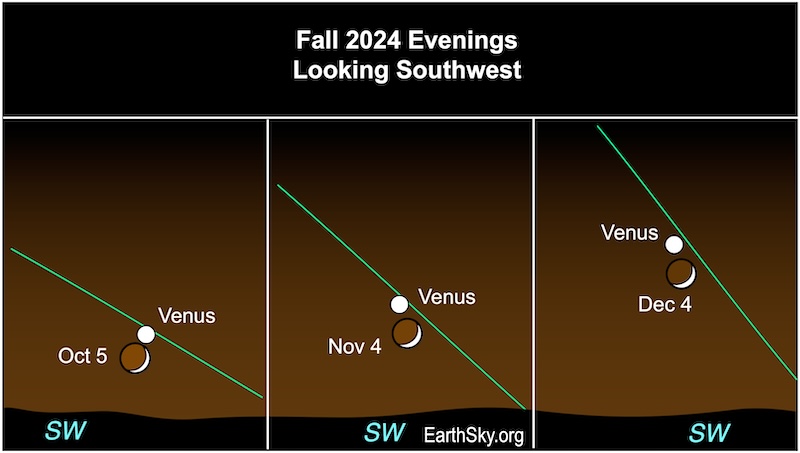
What’s that bright star by the moon?
Anyone with a clear view to the western horizon on the evenings of October 5, November 4 and December 4 may wonder, “What’s that bright star by the moon?” But it isn’t a star at all. It’s the planet Venus! Venus is the brightest planet we see from Earth. The thick clouds on the closest planet to us make it especially reflective and bright. And when it pairs with a young waxing crescent moon, it’s quite the sight!
The moon and Venus are less than 5 degrees apart on October 5, 2024. By November, the closest pairing of the moon and Venus is on the 4th. Once again, they’re less than 5 degrees apart, or the amount of space that your three middle fingers block on the sky’s dome when held at arm’s length.
In the Northern Hemisphere, because we’re headed toward the winter solstice, the sun will be setting earlier each night. So by the time Venus and the moon are close again on December 4, they’ll be up in darkness for a bit longer. You may be able to spot some of the stars of Sagittarius and the shape of the Teapot before they set below the southwestern horizon.
For a precise view from your location, visit Stellarium.
Bottom line: What’s that bright star by the moon? It’s not a star at all. It’s the planet Venus! Venus is the brightest point of light in our night sky, and on three evenings in the fall sky, it pairs with the crescent moon after sunset. Learn more here.
The post What’s that bright star by the moon? It’s Venus! first appeared on EarthSky.
from EarthSky https://ift.tt/1vY6rKL

What’s that bright star by the moon?
Anyone with a clear view to the western horizon on the evenings of October 5, November 4 and December 4 may wonder, “What’s that bright star by the moon?” But it isn’t a star at all. It’s the planet Venus! Venus is the brightest planet we see from Earth. The thick clouds on the closest planet to us make it especially reflective and bright. And when it pairs with a young waxing crescent moon, it’s quite the sight!
The moon and Venus are less than 5 degrees apart on October 5, 2024. By November, the closest pairing of the moon and Venus is on the 4th. Once again, they’re less than 5 degrees apart, or the amount of space that your three middle fingers block on the sky’s dome when held at arm’s length.
In the Northern Hemisphere, because we’re headed toward the winter solstice, the sun will be setting earlier each night. So by the time Venus and the moon are close again on December 4, they’ll be up in darkness for a bit longer. You may be able to spot some of the stars of Sagittarius and the shape of the Teapot before they set below the southwestern horizon.
For a precise view from your location, visit Stellarium.
Bottom line: What’s that bright star by the moon? It’s not a star at all. It’s the planet Venus! Venus is the brightest point of light in our night sky, and on three evenings in the fall sky, it pairs with the crescent moon after sunset. Learn more here.
The post What’s that bright star by the moon? It’s Venus! first appeared on EarthSky.
from EarthSky https://ift.tt/1vY6rKL

Aucun commentaire:
Enregistrer un commentaire